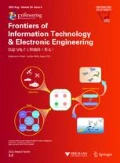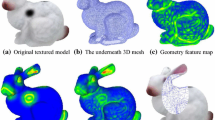Abstract
In the area of 3D digital engineering and 3D digital geometry processing, shape simplification is an important task to reduce their requirement of large memory and high time complexity. By incorporating the content-aware visual salience measure of a polygonal mesh into simplification operation, a novel feature-aware shape simplification approach is presented in this paper. Owing to the robust extraction of relief heights on 3D highly detailed meshes, our visual salience measure is defined by a center-surround operator on Gaussian-weighted relief heights in a scale-dependent manner. Guided by our visual salience map, the feature-aware shape simplification algorithm can be performed by weighting the high-dimensional feature space quadric error metric of vertex pair contractions with the weight map derived from our visual salience map. The weighted quadric error metric is calculated in a six-dimensional feature space by combining the position and normal information of mesh vertices. Experimental results demonstrate that our visual salience guided shape simplification scheme can adaptively and effectively re-sample the underlying models in a feature-aware manner, which can account for the visually salient features of the complex shapes and thus yield better visual fidelity.
Similar content being viewed by others
References
Botsch, M., Pauly, M., Kobbelt, L., et al., 2007. Geometric modeling based on polygonal meshes. ACM SIGGRAPH, Course Notes, Article 1. [doi:10.1145/1281500.1281640]
Cignoni, P., Rocchini, C., Scopigno, R., 1998. Metro: measuring error on simplified surfaces. Comput. Graph. Forum, 17(2):167–174. [doi:10.1111/1467-8659.00236]
Cohen, J., Varshney, A., Manocha, D., et al., 1996. Simplification envelopes. Proc. 23rd Annual Conf. on Computer Graphics and Interactive Techniques, p.119–128. [doi:10.1145/237170.237220]
Corsini, M., Larabi, M.C., Lavoué, G., et al., 2013. Perceptual metrics for static and dynamic triangle meshes. Comput. Graph. Forum, 32(1):101–125. [doi:10.1111/cgf.12001]
Fleming, R.W., Singh, M., 2009. Visual perception of 3D shape. ACM SIGGRAPH, Course Notes, Article 24. [doi:10.1145/1667239.1667263]
Garland, M., Heckbert, P.S., 1997. Surface simplification using quadric error metrics. Proc. 24th Annual Conf. on Computer Graphics and Interactive Techniques, p.209–216. [doi:10.1145/258734.258849]
Garland, M., Heckbert, P.S., 1998. Simplifying surfaces with color and texture using quadric error metrics. Proc. IEEE Visualization, p.263–269.
Hoppe, H., 1996. Progressive meshes. Proc. 23rd Annual Conf. on Computer Graphics and Interactive Techniques, p.99–108. [doi:10.1145/237170.237216]
Hoppe, H., 1999. New quadric metric for simplifying meshes with appearance attributes. Proc. IEEE Visualization, p.59–66. [doi:10.1109/VISUAL.1999.809869]
Hoppe, H., DeRose, T., Duchamp, T., et al., 1993. Mesh optimization. Proc. 20th Annual Conf. on Computer Graphics and Interactive Techniques, p.19–26. [doi:10.1145/166117.166119]
Howlett, S., Hamill, J., O’Sullivan, C., 2005. Predicting and evaluating saliency for simplified polygonal models. ACM Trans. Appl. Percept., 2(3):286–308. [doi:10.1145/1077399.1077406]
Itti, L., Koch, C., Niebur, E., 1998. A model of saliency-based visual attention for rapid scene analysis. IEEE Trans. Patt. Anal. Mach. Intell., 20(11):1254–1259. [doi:10.1109/34. 730558]
Lee, C.H., Varshney, A., Jacobs, D.W., 2005. Mesh saliency. ACM Trans. Graph., 24(3):659–666. [doi:10.1145/1073 204.1073244]
Liu, Y., Liu, M., Kihara, D., et al., 2007. Salient critical points for meshes. Proc. ACM Symp. on Solid and Physical Modeling, p.277–282. [doi:10.1145/1236246.1236285]
Luebke, D., 2001. A developer’s survey of polygonal simplification algorithms. IEEE Comput. Graph. Appl., 21(1): 24–35. [doi:10.1109/38.920624]
Luebke, D., Hallen, B., 2001. Perceptually driven simplification for interactive rendering. Proc. 12th Eurographics Workshop on Rendering, p.223–234. [doi:10.2312/EGWR/EGWR01/223-234]
Luebke, D., Reddy, M., Cohen, J.D., et al., 2003. Level of detail for 3D graphics. Morgan Kaufman Publishers, San Francisco, CA, USA.
Miao, Y., Bösch, J., Pajarola, R., et al., 2012a. Feature sensitive re-sampling of point set surfaces with Gaussian spheres. Sci. China Inform. Sci., 55(9):2075–2089. [doi:10. 1007/s11432-012-4637-0]
Miao, Y., Feng, J., Wang, J., et al., 2012b. A multi-channel salience based detail exaggeration technique for 3D relief surfaces. J. Comput. Sci. Technol., 27(6):1100–1109. [doi:10.1007/s11390-012-1288-y]
Ohtake, Y., Belyaev, A., Seidel, H.P., 2002. Mesh smoothing by adaptive and anisotropic Gaussian filter applied to mesh normals. Proc. Vision, Modeling and Visualization, p.203–210.
Press, W.H., Teukolsky, S.A., Vetterling, W.T., et al., 1992. Numerical Recipes in C: the Art of Scientific Computing (2nd Ed.). Cambridge University Press, New York.
Qu, L., Meyer, G.W., 2008. Perceptually guided polygon reduction. IEEE Trans. Visual. Comput. Graph., 14(5): 1015–1029. [doi:10.1109/TVCG.2008.51]
Shilane, P., Funkhouser, T., 2007. Distinctive regions of 3D surfaces. ACM Trans. Graph., 26(2):7:1–7:15. [doi:10.1145/1243980.1243981]
Todd, J.T., 2004. The visual perception of 3D shape. Trends Cogn. Sci., 8(3):115–121. [doi:10.1016/j.tics.2004.01. 006]
van Kaick, M., Pedrini, H., 2006. A comparative evaluation of metrics for fast mesh simplification. Comput. Graph. Forum, 25(2):197–210. [doi:10.1111/j.1467-8659.2006.00935.x]
Wei, J., Lou, Y., 2010. Feature preserving mesh simplification using feature sensitive metric. J. Comput. Sci. Technol., 25(3):595–605. [doi:10.1007/s11390-010-9348-7]
Williams, N., Luebke, D., Cohen, J.D., et al., 2003. Perceptually guided simplification of lit, textured meshes. Proc. Symp. on Interactive 3D Graphics, p.113–121. [doi:10. 1145/641480.641503]
Wu, Y., He, Y., Cai, H., 2004. QEM-based mesh simplification with global geometry features preserved. Proc. 2nd Int. Conf. on Computer Graphics and Interactive Techniques in Australasia and South East Asia, p.50–57. [doi:10.1145/988834.988843]
Xiao, C., Fu, H., Tai, C.L., 2009. Hierarchical aggregation for efficient shape extraction. Vis. Comput., 25(3):267–278. [doi:10.1007/s00371-008-0226-z]
Xing, L.P., Hui, K.C., 2012. A visual and geometry-based hybrid approach for surface simplification. Comput.-Aid. Des. Appl., 9(2):167–176. [doi:10.3722/cadaps.2012.167-176]
Zatzarinni, R., Tal, A., Shamir, A., 2009. Relief analysis and extraction. ACM Trans. Graph., 28(5):136:1–136:7. [doi:10.1145/1618452.1618482]
Author information
Authors and Affiliations
Corresponding author
Additional information
Project supported by the National Natural Science Foundation of China (No. 61272309) and the Key Laboratory of Visual Media Intelligent Process Technology of Zhejiang Province, China (No. 2011E10003)
Rights and permissions
About this article
Cite this article
Miao, Yw., Hu, Fx., Chen, My. et al. Visual salience guided feature-aware shape simplification. J. Zhejiang Univ. - Sci. C 15, 744–753 (2014). https://doi.org/10.1631/jzus.C1400097
Received:
Accepted:
Published:
Issue Date:
DOI: https://doi.org/10.1631/jzus.C1400097




